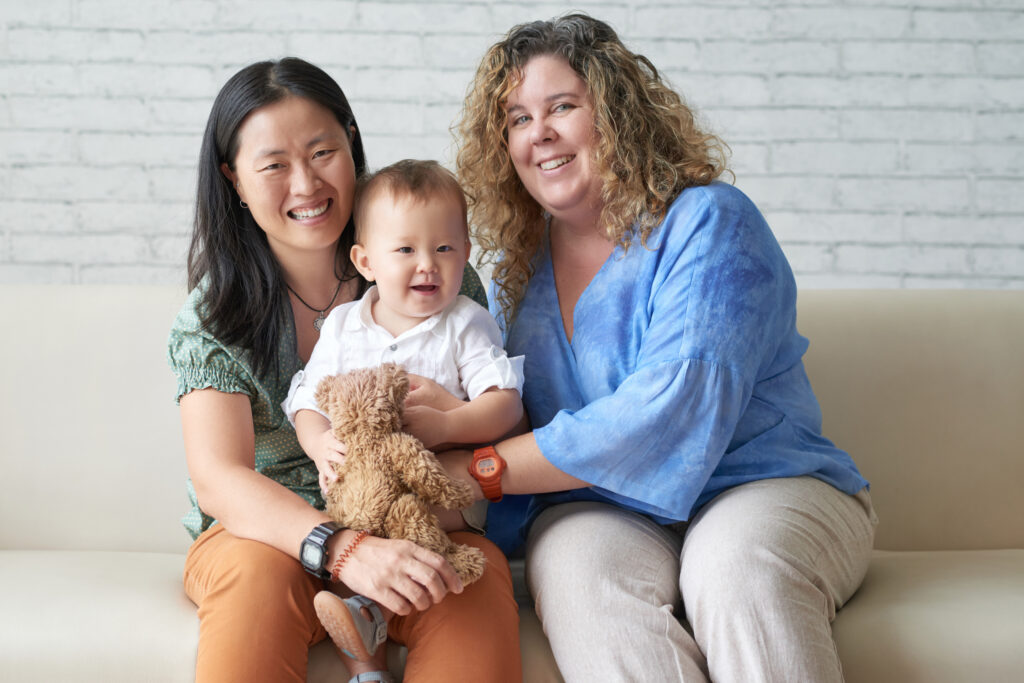Lesbian family planning: How to become a genetically-linked parent
Contributed by Dr. Mark Leondires, Reproductive Medicine Associates of Connecticut and Gay Parents to Be.
Congratulations on deciding to become parents! As a same-sex female couple, there are several family-building options available to you. The first question to ask is: Do you want to proceed with biological family building (where you and/or your partner could conceive a genetically-linked child), or do you want to pursue adoption? What are biological family building options for lesbians?
If you decide to move forward with a genetically-linked child, there are a few different family building options for lesbians. An excellent first step for any of these family planning pathways is a fertility workup.

How do I understand my fertility?
Complete a basic fertility workup to evaluate your reproductive age – which may be different from your actual calendar age. This workup includes a basic panel of tests that can determine your baseline level of fertility and your chance for a successful and healthy pregnancy.
When you are undergoing a fertility workup, your menstrual cycle is measured from the first day of your period (blood flow, not spotting), so Cycle Day 3 is the third day of your period. On Day 3 you would have bloodwork done to check three important levels:
- The FSH blood test helps diagnose problems with sexual development, menstruation, and fertility. Your FSH level can be used to diagnose or evaluate polycystic ovary disease, ovarian cysts, irregular vaginal bleeding and infertility. FSH is secreted by the pituitary (a gland in the brain) throughout the menstrual cycle, but on day 3 it should be low – indicating good fertility.
- The LH blood test measures the amount of luteinizing hormone, which is also secreted by the pituitary gland. In women, LH levels rise mid-cycle. Then, within 24 to 36 hours, ovulation typically occurs. Higher-than-normal levels of LH can indicate several disorders, including ovarian failure and polycystic ovary disease (PCOS).
- Estradiol is the most important form of estrogen. It is primarily made in and released from the ovaries, adrenal cortex and the placenta, and it is responsible for the growth of the breasts, outer genitals, uterus, fallopian tubes and vagina. Estradiol is a complementary hormone which is secreted by the ovary and correlates proper time of the FSH test.
What is an AMH test? What is Anti-Müllerian hormone?
- An Anti-Müllerian hormone (AMH) test is used to measure ovarian reserve, which can indicate the quality and quantity of your remaining eggs. Your AMH test result helps doctors determine your chances of becoming pregnant now and in the future. This blood test can be done at any point in the menstrual cycle.
Another way that your physician or fertility specialist may measure your fertility is by performing an HSG. A hysterosalpingogram (HSG) is a short procedure used to evaluate the status of your fallopian tubes – which carry eggs from your ovaries to the uterus. An HSG also looks at your uterus, to make sure it has a normal shape and size and to identify any other adhesions, polyps or fibroids. These problems are important to note, as they may cause painful menstrual periods or repeated miscarriages.
While you’re learning about your fertility baseline, it’s a good time to consider your family building options. If you haven’t already done so, this is also a great time to schedule a consultation with a fertility specialist, who can help you understand your fertility and plan for your future family.

Lesbian Family Planning Options
Option 1 – Intra-uterine Insemination (IUI)
What is an IUI?
Intra-uterine insemination (IUI), more commonly known as assisted or artificial insemination (AI), is a process used to place sperm into a woman’s reproductive tract. The procedure involves concentrating semen into a small volume and placing it into the uterus to increase your chances of conceiving.
To begin this process, you need to see your primary care physician. Be sure to stay up to date on all health care maintenance, including your pap smear and mammogram if recommended. It is essential to track your cycle each month, as cycle tracking will help you complete the insemination at the right time. Some OB/GYNs will require a basic fertility evaluation, including a hysterosalpingogram (HSG) and documentation of ovulation, as mentioned above!
The next step in this process is to meet with a board-certified Reproductive Endocrinologist. Learn more about what makes a practice LGBTQ-friendly here. At this meeting with your fertility specialist, you would discuss an insemination pathway, as well as your choice of sperm donors.
What is a Known Sperm Donor?
A known donor can be a family member or friend, but requires careful consideration and consultation with an attorney to protect parental rights and to be sure that all adults are invested in the emotional development the child to be.
What is the Difference Between a Known and Anonymous Sperm Donor?
An anonymous donor can be found through a sperm bank. As the name implies, parents do not know the donor, including his name or medical history. However, recipients can choose a sperm donor based on essential characteristics such as family history, race, academic achievements, looks and other factors. This is considered by many to be the safest way to choose a donor, as these donors have been screened thoroughly for infectious diseases, genetic risk factors, and have been counseled on their release of parental rights.
What is an Open-Door Donation?
Many sperm banks offer a known or open-door sperm donor option. This is a sperm donor who is willing to be known to the parents and child, who has been screened by the sperm bank. In both anonymous and open door sperm donations, the donor’s specimen is shipped to your physician frozen, then thawed the day of your insemination.
After you make your donor choice, you will then proceed into either a natural cycle with insemination or a cycle using superovulation and insemination. Superovulation uses fertility medicine, so you release more than one egg per month to increase your chances of pregnancy. This can dramatically increase your per-cycle chance of pregnancy. Your personal medical care team will help guide you to decide what’s right for you.
Then, at the appropriate time in your cycle, donor sperm is introduced into your uterus. This procedure is very low risk, takes about 5-10 minutes, and is done in the office.
Option 2 – In Vitro Fertilization (IVF)
How does IVF work for a lesbian couple?
In vitro fertilization (IVF) is a family planning pathway for same-sex female couples (or single women) where only one partner wants to biologically and genetically participate in the pregnancy, and perhaps has completed IUI treatment unsuccessfully, or is struggling with their fertility. IVF is a process that involves stimulating that partner’s ovaries with medications to develop multiple eggs, creating embryos in the laboratory, and then placing those embryos back into that same partner’s uterus.
To move forward with IVF treatment for lesbian single women or couples, you should see a board certified Reproductive Endocrinologist. Baseline fertility screening is required to complete IVF using one person’s egg and uterus, as described in the beginning of this article. A saline sonogram (SHG) is also needed to investigate the health of your uterus.
Over 8 million babies have now been born via in vitro fertilization. IVF is considered safe for women, and one of the most successful fertility treatment options available. IVF treatment would involve injectable medication leading up to the procedure known as an egg retrieval, which is minimally invasive and completed under sedation at your fertility clinic. After your embryos have been created, the embryo transfer is also completed at your fertility clinic.
Option 3 – Reciprocal IVF
What is Reciprocal IVF?
With reciprocal IVF, one partner’s eggs are used to create embryos, and then the other partner carries the pregnancy and delivers the child. For same-sex female couples, this is a way that both partners can contribute to the family building process uniquely. The first partner will take fertility medicines to produce multiple eggs, and undergo the egg retrieval. Only this partner will be genetically linked to the future child. Those eggs are then combined with the designated donor sperm in the IVF laboratory, while the partner who is choosing to become pregnant goes on medication to prepare their uterus. Then, when the timing is optimal, embryos are transferred into the second partner’s uterus. This is a wonderful option in situations where both partners want to participate in the pregnancy!
Success rates with reciprocal IVF vary with a woman’s age (among other factors). If an IVF cycle is successful, and results in a pregnancy, women are discharged to their OB-GYN in about six weeks.
A Few Things To Keep In Mind
If you decide that biological family building is right for you, there are three routes to pregnancy for same-sex women as mentioned above: IUI, IVF using one partner’s eggs & uterus, or reciprocal IVF. It is important to note that success rates vary based on individual treatments and circumstances, and just because one pathway worked for a friend or acquaintance, doesn’t mean it will be the right treatment plan for you.
It is also essential to remember that picking a sperm donor is a very important part of this process, as this person will be linked to your child’s creation story that you share with them as they grow. We recommend that you meet with an experienced reproductive mental health professional to help you with this decision, as it is a lifelong one for you and your child.
One last note: success rates for women remain very high for women under the age of 40, but age is a significant predictor for success. I recommend you work with a board-certified Reproductive Endocrinologist to assure that your pathway to pregnancy is successful, safe, and time efficient.
Good luck in your family building journey, take the time to get educated, and stay hopeful!

ABOUT THE AUTHOR
Dr. Mark P. Leondires, Medical Director and lead infertility doctor with Reproductive Medicine Associates of Connecticut (RMACT), is board-certified in both Obstetrics and Gynecology and Reproductive Endocrinology and Infertility.





